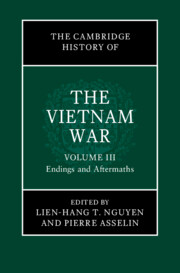Book contents
- The Cambridge History of the Vietnam War
- The Cambridge History of the Vietnam War
- The Cambridge History of the Vietnam War
- Copyright page
- Contents
- Figures
- Maps
- Contributors to Volume III
- General Introduction
- Introduction
- Part I The Late Vietnam War
- Part II The Postwar Era
- 13 Vietnam after “Liberation”
- 14 The Third World and the Communist Triumph in Vietnam
- 15 The Third Indochina War
- 16 Vietnam in the Reform Era
- 17 Postwar US–Vietnam Relations
- 18 Refugees and US–Vietnam Relations
- 19 The US POW Experience, American Veterans, and the War
- Part III Legacies
- Index
18 - Refugees and US–Vietnam Relations
from Part II - The Postwar Era
Published online by Cambridge University Press: 02 January 2025
- The Cambridge History of the Vietnam War
- The Cambridge History of the Vietnam War
- The Cambridge History of the Vietnam War
- Copyright page
- Contents
- Figures
- Maps
- Contributors to Volume III
- General Introduction
- Introduction
- Part I The Late Vietnam War
- Part II The Postwar Era
- 13 Vietnam after “Liberation”
- 14 The Third World and the Communist Triumph in Vietnam
- 15 The Third Indochina War
- 16 Vietnam in the Reform Era
- 17 Postwar US–Vietnam Relations
- 18 Refugees and US–Vietnam Relations
- 19 The US POW Experience, American Veterans, and the War
- Part III Legacies
- Index
Summary
In the two decades after 1975, over 1 million Vietnamese resettled in the United States. New resettlement programs arose not only in 1975 with the fall of Saigon and in the years immediately thereafter, but also in 1979, 1982, 1984, 1987, 1989, and 1996. These initiatives resulted from unilateral US policies, multilateral programs organized under the auspices of the UN High Commissioner for Refugees, bilateral programs negotiated between Washington and Hanoi, and, often, a combination of the three. This chapter explores how the Vietnamese diaspora influenced the American approach to normalization with the Socialist Republic of Vietnam (SRV). It argues that normalization was a protracted process that unfolded over decades and that negotiating and implementing migration programs was a central part of the that process. The US approach to post-1975 US–SRV relations saw significant input from nonexecutive actors. Nonstate actors provided information and political pressure, and created close relationships with elected officials outside the White House, especially members of Congress. These groups, the actions of first-asylum nations, and other transnational forces combined to make negotiating and implementing migration programs a US priority. The contact, cooperation, and compromise that process required normalized US–Vietnamese relations, despite US assertions to the contrary.
Keywords
- Type
- Chapter
- Information
- The Cambridge History of the Vietnam War , pp. 402 - 423Publisher: Cambridge University PressPrint publication year: 2024

